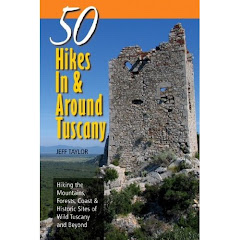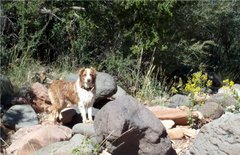Distance: 6 - 10 miles round trip depending on ending point (10-16 km)
Elevation: 1600-1800 feet (490 - 550 m)
Difficulty: Moderate
Time of Year: November to April
Located approximately 60 miles west of Phoenix in the Sonoran Desert, the 106,000 acre Eagletail Wilderness represents one of the finest examples of unspoiled desert landscapes in Western Arizona. This wilderness contains numerous petroglyphs, showing the vibrant native cultures that survived in this harsh landscape for thousands of years. To access the Eagletail Wilderness, take the Harquahala Valley exit off I-10 and drive south to Courthouse Road. Here, turn right and follow the wide dirt road west. At the first set of BLM signs, follow the road as it turns northwest and follow it for a ways until seeing a large BLM sign to the left. Follow this high-clearance road to the trailhead about 1.5 miles up near the base of the massive Courthouse Rock.
 |
| A tarantula strolling across the wash |
The route begins by following an old dirt track into the wilderness just above a deep wash. The trail will eventually descend into the wash itself. Here, turn right and follow the wash for the next 1/2 mile. You will encounter an old barbed wire gate, which you will need to pass through and then continue up as the wash narrows into a small canyon. Soon, the trail will turn left and climb out of the canyon following a side drainage that has been flattened and improved. Once out of the canyon, the trail continues along the top of sediments between the adjacent mountains. Looking across the basin, you can see some dark-colored cliffs about 1 mile in the distance. This is where the petroglyphs are.
The trail continues along until dropping into a wide arroyo. While the trail crosses and then parallels the wash, you can also just walk straight down the wash if you wish. Once you arrive at the dark brown to almost black cliffs, you will start to see some of the petroglyphs on the boulders on the slope. But, if you scramble up the slopes, you will see hundreds more on the cliffs themselves.
This site has significance because it was (and sort of still is) the site of a spring providing a critical source of water in the arid desert. This area only gets around 4" of rain per year, so this spring was basically the only way to survive out here. As you examine the petroglyphs, you will see the classic signs of corn fields aligned with solar angles to tell these ancient people when to plant and harvest their corn.
This site is called Indian Spring, and today it consists of a few mucky pools in potholes within the wash. In wetter times, such as it was 1000 years ago, this spring was probably more reliable than it is today. There is one way to evaluate the age of the petroglyphs by looking at how much of the desert varnish has formed over the surface of these markings. Desert varnish forms when bacteria that live within the rocks excrete minerals onto the surface of the rocks. When chipped into to form a petroglyph, the desert varnish will slowly reform, but it takes hundreds of years. Thus, when you see petroglyphs that have faded into dark brown with a thick layer of varnish, then you know they are really old.
 |
| Indian Springs Canyon |
If you just go to the Petroglyphs and head back the way you came, the hike will be 6 miles roundtrip. However, the Indian Springs Wash heads off into a spectacular canyon at this point and it is most definitely worth wandering down. If you wander down the canyon, there are beautiful black and brown cliffs, thick stands of palo verde and ironwoods along the edges of the wash, and chuckwallas, tarantulas, and other desert species hiking amongst the rocks.
 |
| One of the pools of Indian Springs |
The wash continues for about 1.5 miles until the landscape starts to flatten out. There is a tendency to think that the canyon will open up onto a flat bajada at any time, but instead the hills just soften. But, as the hills on each side of the wash flatten and the wash appears to finally be nearing its end, there is a great place to leave the wash to the left to climb about 80 feet up to the ridgetop. Once on top, there is a spectacular panoramic view of the landscape.
 |
| The unspoiled Eagletail Wilderness |
From this viewpoint, there is not a single trace of human disturbance as far as the eye can see. In fact, for four blissful minutes, I could see or hear nothing of human influence. Until I heard an airplane flying overhead. Anyways, once you are done soaking it in, just retrace your steps and head back to the trailhead over 5 miles of beautiful desert canyons.
 |
| Sunrise on Courthouse Rock |


























